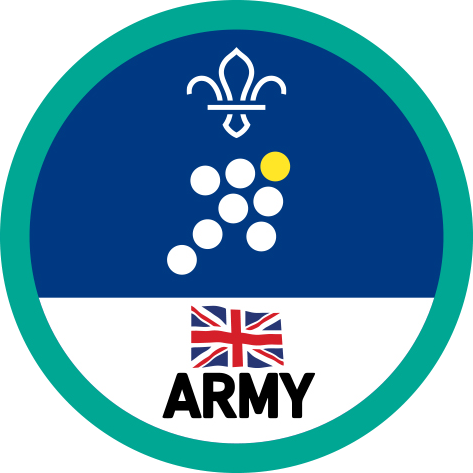
Make your own crazy golf course
You’ll need
- Craft materials (for example, tissue paper, pipe cleaners, stickers)
- Scrap paper
- Scrap card
- Pens or pencils
- Clean items of recycling
- Scissors
- Glue sticks
- Sticky tape
- Small plastic balls
- Optional decorations and obstacles (artificial grass, rocks, small flags)
Before you begin
- Use the safety checklist to help you plan and risk assess your activity. There's additional guidance to carry out your risk assessment, including examples.
- Make sure all young people and adults involved in the activity know how to take part safely.
- Make sure you’ll have enough adult helpers. You may need some parents and carers to help if you’re short on helpers.
Planning and setting up this activity
- Gather all the recyclable materials and household objects together that are clean, suitable and safe to make a crazy golf hole from.
- Before the session, you may wish to make some putters to help save time. You could use a ping pong ball or some golf balls for the ball.
- Find a suitable space for building the crazy golf course, which could be outside. It could also be on a beach or in a park. You may want to have a separate space for building the course in and one for making the course.
- Lay out the recycled materials and craft supplies for young people to use. You may want to pre-cut some items or make an example crazy golf hole.
- You could print out some scoresheets or use paper to help record the scores.
- You may wish to run this activity over two weeks, with one week building the course and one week playing the course. You could even invite other sections to join you.
Running this activity
- Gather everyone together and explain that you’ll be making your own crazy golf. You may want people to split into groups, pairs or work individually, then assign each group, pair or person to make a hole each. You may wish to assign one team to making the scoresheets, golf flags, golf putters and/or golf balls.
- Before starting, everyone should decide if their crazy golf course should have a theme, such as pirates, chocolate or underwater.
- Tell everyone that there should be a clear place to get the ball into for each hole, such as a plant pot, yogurt pot, tin cans or paper cups. You may wish to have this the same item for each hole, so people know what to aim for each time and you may need to tape them down. You could give them golf flags, made from lollipop sticks and coloured paper triangles.
- Give out paper and pens, then let people design, sketch and build their crazy golf hole using the materials provided. You could encourage the teams to add decorations to their crazy golf holes or add in extra obstacles to make the course more challenging and fun.
- Some ideas are:
-
- Use plastic bottles, garden gnomes or toy skittles as a slalom to move the ball around.
- Cut arches in cardboard boxes for bridges.
- Have a piece of drainpipe or kitchen roll tubes to hit the ball through.
- Use pool noodles to make arches.
- Create a ramp with cardboard or some wood resting on bricks.
- Place open hardback books as tunnels.
- Build a windmill or a castle out of cardboard boxes.
- Use furniture, such as chairs, picnic benches or low tables, to create obstacles.
- Place croquet wickets or tent pegs visibly in the ground for the ball to travel between.
- Use natural items, such as rocks or sandcastles
- Once the course has been built and decorated, the teams can test out the course using their putters and golf balls.
- When you’re ready, each team can go around the course, taking turns to play each hole. People may wish to record their score for each hole, which is how many hits it took people to get the ball into the hole. The lowest score at the end, wins. If you’re keeping track of scores, remember to number each hole, then hand out paper and pens for people to use to write down what they got. You could also make your own scoresheets.
- At the end, make sure you take apart the course carefully and recycle any materials you can. You could also store the course for another section to use.
- Take some newspaper or paper, then crumble it into a ball.
- You may wish to add sticky tape on top and around the ball to make it have flatter, rounded edges.
- You could also use ping pong balls, golf balls or tennis balls.
- Take some newspaper sheets, masking tape and six pieces of paper.
- Start by rolling up and overlapping sheets of newspaper to create a long and strong tube. You could also use a roll of wrapping paper.
- Use plenty of masking tape to keep it together.
- Take three pieces of paper or some scrap cardboard, such as a side of a cereal box. Fold the paper or cardboard in half lengthways, and again. Then fold widthway and tape to the bottom of your newspaper.
- Now you've made one club, try making a second one!
- You could also use real golf putters, or you may want to make it extra fun by using household objects, such as spatulas or wrapping paper tubes.
Reflection
This activity was all about using your creativity, imagination and teamwork to make a crazy golf course. What did you enjoy about making the course? What ideas did you have and how did you choose one?
You had to build the course. How did that go? Did you have the materials you needed? Did you have any problems that you didn’t expect? What happened? Did you have to change your plans or redesign the hole? How close to your original idea was the hole? How did you work together while building it?
This activity was also about testing out the course. Did the course work okay? How difficult were they? Was your crazy golf hole easier or harder than you expected? Would you want to change anything after playing it? What could be made better? How did you all work as a team while playing the game too?
Safety
All activities must be safely managed. You must complete a thorough risk assessment and take appropriate steps to reduce risk. Use the safety checklist to help you plan and risk assess your activity. Always get approval for the activity, and have suitable supervision and an InTouch process.
- Scissors
Supervise young people appropriately when they’re using scissors. Store all sharp objects securely, out of the reach of young people.
- Sharp objects
Teach young people how to use sharp objects safely. Supervise them appropriately throughout. Store all sharp objects securely, out of the reach of young people.
- Glue and solvents
Always supervise young people appropriately when they’re using glue and solvent products. Make sure there’s plenty of ventilation. Be aware of any medical conditions that could be affected by glue or solvent use and make adjustments as needed.
- Rubbish and recycling
All items should be clean and suitable for this activity.
- Active games
The game area should be free of hazards. Explain the rules of the game clearly and have a clear way to communicate that the game must stop when needed. Take a look at our guidance on running active games safely.
- Hand and electric tools
Inspect tools for any damage before each use. An adult should supervise people using tools, and people should follow instructions on how to use them correctly and safely. Tools should be properly maintained and kept sharp.
Use an appropriate surface and make sure materials are stable and supported when you’re working on them. You should cut and drill away from the body and in an area clear of other people. Be extra cautious of trailing cables and water when using electric tools. Always use a cordless tool if one’s available.
- To make this activity easier, you could use equipment available such as benches and chairs. You could even try footgolf, so people just need to kick the ball around the course and into a bucket.
- To make this activity harder, you can give the teams more time to be make harder obstacles, suggest a minimum number of obstacles per course, or add some glow in the dark paint to the course, ball and putters, then try playing in the dark.
- To help save time, you may wish to pre-build and make the course, so people just play the course at the session.
- To make this activity easier, you could use larger, wider putters to help with grip and use tennis balls. You’d just need to make the holes larger, or you could create a flat playing space using chalk to draw elements on the ground. You can make the obstacles less complex too.
- People can work in small groups or as a whole group, depending on what will work best for your group. If needed, let people be in bigger groups to make sure everyone’s supported in taking part in the activity. A Young Leader could join a group to help people to take part, too.
- Picking up materials could be a challenge for some people, so people could work in pairs to assist with collecting. Make sure that all the materials are at a level that can be easily worked on or seen by wheelchair users.
- People can move at their own pace, so you don’t need to make it competitive unless it works for everyone.
- Make sure the course and the area you're exploring is accessible for everyone in your group. You may need to leave more space between the holes or obstacles, so everyone can move around them, including anyone using mobility aids.
All Scout activities should be inclusive and accessible.
If you enjoyed this activity, why not check out some of our other building activities, such as Try making different cardboard creations?
Young people could invite their friends, families and loved ones to try out the course as a fundraising event – or just for fun!

